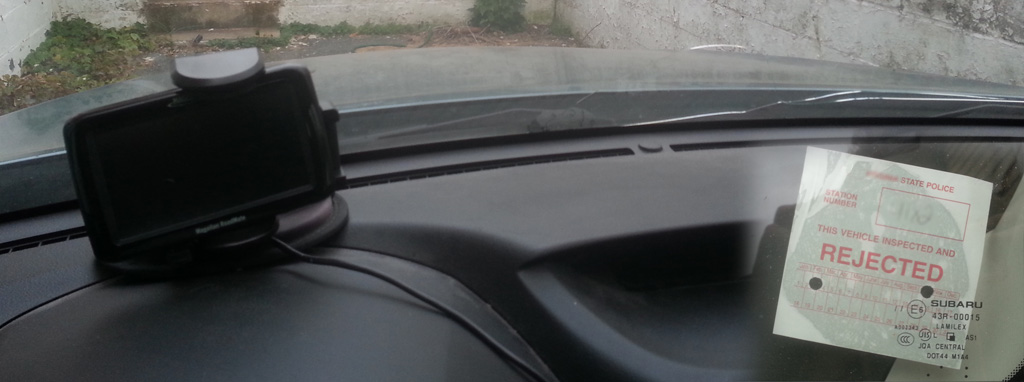In addition to having to get a new driver’s license and car registration, Queenland also has state safety inspections. It’s been a little while since I’ve had to contend with them,, and honestly it’s never been a problem when I have. Until now, anyway.
The Toyota had a problem with the exhaust pipe, which the inspector made a clean $400 off fixing. We could have gotten a second opinion, but we gave them the benefit of the doubt in part because they’re the only inspection station around here and such chores become surprisingly more difficult when you have a baby. And besides, the car is approaching twenty years old. We expect problems to occur.
The Forester had a more verifiable problem. Not long after we got it, we got a crack in the windshield. The crack has been growing in fits and starts ever since. Fortunately, though, it doesn’t affect visibility unless you count my ability to clearly see my front hood. The previous state that I lived in which required safety inspections only cared if it was in the line of sight, but Queenland apparently sees (haha, no pun intended) it differently.
This is not, strictly speaking, a matter of freedom. There are certainly negative externalities when it comes to unsafe cars on the road. If my visibility were obstructed, it would represent a hazard first and foremost to myself, but also to others. Acknowledged.
It reminded me of James K’s post on the price of safety at League of Ordinary Gentlemen. I recommend reading the whole thing. The comment thread runs 370 comments long and, alas, nothing gets resolved. Within the comments, Mr. Blue actually comments about auto inspections being an example of safety regulations unduly impacting the poor (oddly enough, relating back to when he failed inspection for a cracked windshield). He backs off it a bit as not being the best example, but I think it’s a great point. Especially in light of what I was tagged for.
Replacing the windshield was no real burden on my part. It was less than the exhaust repair. But it’s a pretty clear case of something where the danger to myself – much less others – was positively minimal. While $250 isn’t much for me, it is a significant burden for some people. All for access to the thing they need to make money to do things like repair cars with actual problems.
A fair number of accidents on the road may indeed be attributable to car malfunction, but that shouldn’t be the question. The question should be the extent to which an annual (or less) check of certain things reduces them to any significant degree. And whether each thing we are forcing people to address, in itself, would save lives. How many lives, and at what cost?
It’s worth noting that my stance here is not some right-field hyperlibertarian one. Officials in no less than Washington DC came to the same conclusion and chose to junk inspections altogether:
The District of Columbia recently decided that its periodic motor vehicle safety inspections were flab. Performed at a D.C. facility along with emissions tests, the safety checks were junked for an annual savings of about $400,000. In justifying the cut, the D.C. Council cited a lack of data proving periodic safety inspections save lives.
Safety advocates, who’ve worked to expand periodic safety inspections beyond the 19 states that still require them, worry that others will decide to rethink the cost. They acknowledge that the way crashes are reported makes good data hard to come by, but argue that the current economy makes it even more important to check that drivers are maintaining their vehicles.
“Safety inspections are particularly needed in hard economic times, because when you’re on a tight budget, you tend to skip the badly needed maintenance,” says Clarence Ditlow, executive director of the Center for Automotive Safety advocacy group.
Like a broken windshield that obscures my view of the front hood! More seriously, the only danger is that a crack is more likely to explode into something else in the event of a major accident. That’s not nothing, but the aggregate costs of these checks are enormous. To the extent that there are externalities to be addressed, there is already a venue to do so: insurance companies. An optional inspection for a cut on your insurance rate could price out the total costs quite easily. They’d certainly have an incentive to know how much that would save in lives and property damage.
Now, you might say “Ah-ha! Insurance companies favor inspections!” I don’t know that this is true, but I bet it is. Even if it is, though, why shouldn’t they? Even if it does absolutely no good, it doesn’t cost them a dime. Let them put their money where their mouth is, if this is important. They don’t even have to wait for a state to end auto inspections. Most states don’t presently have them.
About the Author
please enter your email address on this page.

